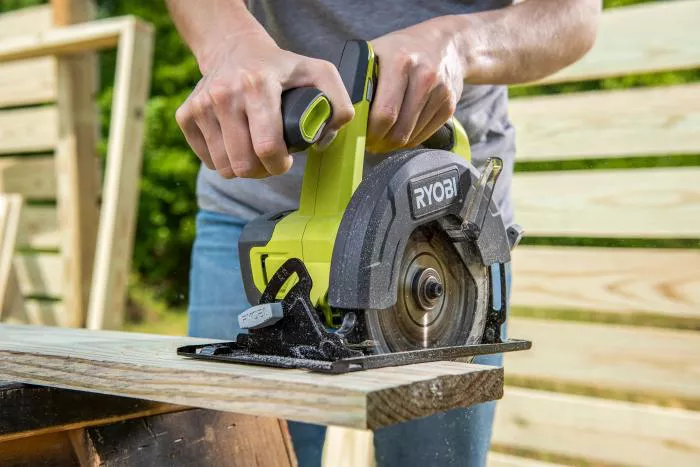A circular saw is one of the most common power tools found in workshops. This versatile cutting tool uses a toothed blade to make quick work of various materials. Many DIY enthusiasts and professionals rely on it for woodworking projects.
The circular saw’s design seems simple at first glance. An electric motor spins a circular blade at high speeds. The user guides the saw through the material to create cuts. But achieving straight cuts requires proper technique and understanding of the tool.
Factors Affecting Cutting Accuracy
Several elements influence whether a circular saw cuts straight. The blade quality plays a significant role. Dull or damaged blades tend to wander during cuts. Blade thickness also matters, with thinner blades being more prone to deflection.
Motor power affects cutting performance. Underpowered saws may bog down in dense materials, causing uneven cuts. The saw’s base plate must remain flat against the work surface for accurate cuts. Any warping or damage to this component will compromise straight cuts.
Proper Setup for Straight Cuts
Achieving straight cuts begins with proper saw setup. Always ensure the blade is sharp and appropriate for the material. Check that the blade is perpendicular to the base plate. Most saws have adjustment mechanisms for this purpose.
Use guides whenever possible. A straightedge clamped to the workpiece serves as an excellent guide. Many circular saws come with parallel guides that attach to the base plate. These help maintain consistent distance from the edge.
Cutting Technique Matters
Even with perfect setup, poor technique leads to crooked cuts. Apply steady, even pressure throughout the cut. Let the saw do the work without forcing it. Moving too fast causes binding, while moving too slow may burn the material.
Maintain firm control with both hands. One hand operates the trigger while the other guides the saw along the cut line. Keep your body positioned to see the blade’s path clearly. Proper stance improves control and accuracy.
Common Mistakes to Avoid
Many users make simple errors that affect cut quality. Not supporting the workpiece properly leads to tear-out. Cutting freehand without guides often results in wandering cuts. Neglecting to check blade alignment causes angled cuts.
Another frequent mistake involves blade depth setting. The blade should extend just below the material’s thickness. Excessive blade exposure increases the risk of deflection and kickback.
Maintaining Your Circular Saw
Regular maintenance ensures consistent performance. Clean the saw after each use, removing dust and debris. Lubricate moving parts as recommended by the manufacturer. Check and tighten all fasteners periodically.
Store the saw properly to prevent damage. Use blade guards when not in use. Replace worn components immediately. A well-maintained saw performs better and lasts longer.
Choosing the Right Blade
Blade selection significantly impacts cut quality. Consider tooth count, tooth geometry, and blade material. Higher tooth counts produce smoother cuts in wood. Fewer teeth work better for rough cuts and dense materials.
Carbide-tipped blades stay sharp longer than steel blades. Specialized blades exist for different materials like metal or masonry. Always match the blade to your specific cutting needs.
Advanced Straight Cutting Methods
For critical precision work, consider advanced techniques. Build a simple cutting jig from plywood for repeatable straight cuts. Use a track system designed for circular saws. These systems provide rail-like guidance for perfect straight cuts.
Some professionals modify their saws by adding aftermarket guides. Laser guides help visualize the cut path. Digital angle finders assist in precise bevel cuts. These upgrades enhance accuracy but require proper calibration.
Safety Considerations
Always prioritize safety when using power tools. Wear appropriate personal protective equipment. Eye protection is essential when operating any saw. Hearing protection reduces noise exposure.
Keep hands away from the cutting path. Be aware of kickback dangers. Never reach under the material while cutting. Follow all manufacturer safety guidelines for your specific saw model.
Troubleshooting Crooked Cuts
If your saw isn’t cutting straight, diagnose the issue systematically. Check blade condition and alignment first. Inspect the base plate for flatness. Verify that all adjustments are properly tightened.
Test cuts on scrap material help identify problems. Compare results using different blades or techniques. Sometimes the issue lies with the workpiece rather than the saw. Warped or uneven materials challenge even the best saws.
Comparing Circular Saws to Other Tools
While circular saws excel at straight cuts, other tools may suit specific needs better. Table saws offer superior precision for repetitive cuts. Miter saws handle angled cuts more efficiently. Band saws work better for curved cuts.
Consider the project requirements when choosing tools. Circular saws provide excellent portability and versatility. Their ability to make straight cuts depends largely on user skill and proper setup.
Conclusion
A circular saw can indeed cut straight when used correctly. The key lies in proper setup, good technique, and quality equipment. Understanding the tool’s limitations and capabilities leads to better results. With practice and attention to detail, anyone can achieve professional-quality straight cuts using a circular saw. Regular maintenance and proper blade selection further enhance performance. Always remember that safety should never be compromised when working with power tools.
Relate topics:
- Can You Cut Wood With a Metal Circular Saw?
- The View Of The dewalt circular saw
- 5 Best Milwaukee Circular Saw

